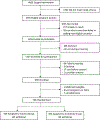Cost-effectiveness of stop smoking incentives for medicaid-enrolled pregnant women
- PMID: 34450189
- PMCID: PMC8595618
- DOI: 10.1016/j.ypmed.2021.106777
Cost-effectiveness of stop smoking incentives for medicaid-enrolled pregnant women
Abstract
Maternal smoking increases mortality and morbidity risks for both mother and infant. The First Breath Wisconsin study examined the cost-effectiveness of providing incentives to pregnant women who smoked to engage in stop smoking treatment. Participants (N = 1014) were Medicaid-enrolled pregnant women recruited from September 2012 to April 2015 through public health departments, private, and community health clinics in Wisconsin. The incentive group (n = 505) could receive $460 for completing pre-birth visits ($25 each), post-birth home visits ($40, $25, $25, $40 for 1-week, 2-month, 4-month and 6-month visits), monthly smoking cessation phone calls post-birth ($20 each), and biochemically-verified tobacco abstinence at 1-week ($40) and 6-months ($40) post-birth. The control group (n = 509) received up to $80 for 1-week ($40) and 6-month ($40) post-birth assessments. Intervention costs included incentive payments to participants, counselor and administrative staff time, and smoking cessation medications. Cost-effectiveness analysis calculated the incremental cost-effectiveness ratio (ICER) per one additional smoker who quit. The incentive group had higher 6-month post-birth biochemically-confirmed tobacco abstinence than the control group (14.7% vs. 9.2%). Incremental costs averaged $184 per participant for the incentive group compared to controls ($317 vs $133). The ICER of financial incentives was $3399 (95% CI $2228 to $8509) per additional woman who was tobacco abstinent at 6 months post-birth. The ICER was lower ($2518 vs $4760) for women who did not live with another smoker. This study shows use of financial incentives for stop smoking treatment is a cost-effective option for low-income pregnant women who smoke.
Keywords: Clinical trials; Cost-effectiveness; Medicaid; Smoking and tobacco.
Copyright © 2021. Published by Elsevier Inc.
Figures
References
-
- Baker TB, Fraser DL, Kobinsky K, Adsit R, Smith SS, Khalil L, … Fiore MC (2018). A randomized controlled trial of financial incentives to low income pregnant women to engage in smoking cessation treatment: Effects on post-birth abstinence. J Consult Clin Psychol, 86(5), 464–473. doi:10.1037/ccp0000278 - DOI - PubMed
-
- Briggs AH, Mooney CZ, & Wonderling DE (1999). Constructing confidence intervals for cost-effectiveness ratios: an evaluation of parametric and non-parametric techniques using Monte Carlo simulation. Stat Med, 18(23), 3245–3262. Retrieved from http://www.ncbi.nlm.nih.gov/pubmed/10602149 - PubMed
Publication types
MeSH terms
Grants and funding
LinkOut - more resources
Full Text Sources
Miscellaneous



